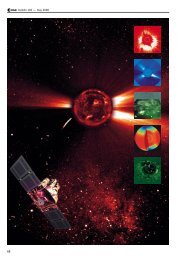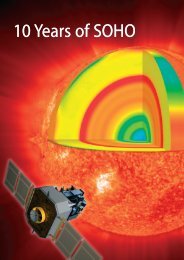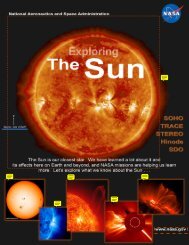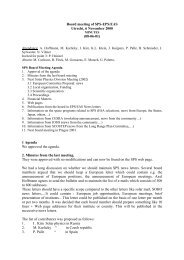Create successful ePaper yourself
Turn your PDF publications into a flip-book with our unique Google optimized e-Paper software.
<strong>Tracking</strong> <strong>Sunspots</strong><br />
Using real data from SOHO<br />
A teacher-led classroom exercise for pairs of students
You are about ready to start observing and tracking sunspots<br />
across the Sun using real images. You can then use this<br />
information to determine the rate of the Sun’s rotation.<br />
Some sunspot facts:<br />
• <strong>Sunspots</strong> are dark, cooler areas on the Sun’s surface that<br />
indicate areas of strong magnetic activity<br />
• They appear dark only because they are not as hot or bright<br />
as the area surrounding them (4,000 degrees C. vs. 6,000<br />
degrees C.)<br />
• <strong>Sunspots</strong> extend down into the Sun as well as above where<br />
loops of magnetic field lines carry charged particles<br />
• They can last from just hours to several months<br />
How BIG are they Next page…
<strong>Sunspots</strong>, which usually appear in groups,<br />
can grow to many times the size of Earth<br />
Approx. size<br />
of Earth
How and when did scientists discover that<br />
there were spots on the Sun<br />
The first telescope was made in Europe in 1608. Galileo, who first<br />
performed scientific observations in the early 1613, concluded that<br />
the Sun did indeed have spots. If, as others suggested, these spots<br />
are planets passing in front of the Sun, they’d be the same in the<br />
center as near the edges. He noted changes in size and shape. Other<br />
scientists came to similar conclusions.<br />
Galileo and one of his<br />
original sunspot<br />
drawings
To begin, first print out the mapping grid on<br />
the following page -- each two-person team<br />
will need one
Mapping grid
How to proceed<br />
• Divide the class into teams of two students, then have<br />
the teams assigned to track one of three marked<br />
sunspot groups: (A), (B), or (C)<br />
• Show the sunspot images from June 22 to July 3<br />
• For each day, one team member notes on their printed<br />
grid where the group Groups A, B, C are, and note the<br />
date and any changes in shape or size. The other writes<br />
down its position in terms of longitude (for example,<br />
spot A appears at -60 longitude on June 23).<br />
• We are pretending that for each day we are stepping<br />
outside at about the same time each day, projecting the<br />
sunspots onto paper, and tracing where they appear.<br />
Thus, we are observing and recording sunspots.
C<br />
A
June 23<br />
C<br />
B<br />
A
June 24<br />
C<br />
B<br />
A
June 25<br />
C<br />
B<br />
A
June 26<br />
C<br />
B<br />
A
June 27<br />
C<br />
B<br />
A
June 28<br />
C<br />
B<br />
A
June 29<br />
C<br />
B<br />
A
June 30<br />
C<br />
B<br />
A
July 1<br />
C<br />
B<br />
A
July 2<br />
B<br />
C<br />
A
July 3<br />
B
Sample mapping worksheet
Sample data recorded<br />
(numbers are approximate)<br />
Spot Group A B C<br />
Longitude<br />
June 22 -60 -- -60<br />
June 23 -45 -58 -45<br />
June 24 -30 -30 -33<br />
June 25 -18 -23 -20<br />
June 26 -12 -12 -13<br />
June 27 8 -7 4<br />
June 28 23 5 17<br />
June 29 33 17 30<br />
June 30 43 23 38<br />
July 01 55 42 53<br />
July 02 65 56 --<br />
July 03 -- 70 --
Analysis<br />
• Team members should review their data to make<br />
sure that the numbers match the drawings.<br />
• Next, determine about how many degrees of<br />
longitude their group moved each day.<br />
• To get the average daily movement, determine the<br />
the total degrees of change noted from one day to<br />
the next. Next, add these up,and divide by the<br />
number of days these represent.<br />
• Do the A, B, and C teams agree Did all sunspot<br />
groups move at about the same rate What was the<br />
average<br />
• Did some spots seems to change in size or shape
What can we conclude<br />
• The sunspots seem to be moving at about 12<br />
degrees per day. Now we are ready to answer the<br />
BIG question: How long does it seem to take the<br />
Sun to make a full rotation of 360 degrees<br />
• But remember, because the Earth is moving<br />
around the Sun in the same direction at about 1<br />
degree per day (almost 365 days to circle the Sun<br />
in a year), we need to add one degree per day to<br />
the apparent movement to allow for this (Earth’s<br />
movement makes it seem like the Sun is rotating<br />
less than it really is).
How long does it take to rotate<br />
• Congratulations! Your basic calculations<br />
are correct: the Sun does rotate every<br />
27 days at its middle, about where the<br />
spots we observed appeared.<br />
Note: The Sun, being a gaseous body - not a solid<br />
object - does not rotate at the same speed all over<br />
its surface: thus, it rotates about every 35 days<br />
near its poles.
Watch the frames be put into motion!<br />
Click on image to start movie<br />
Remember that you can see daily images of sunspots on the SOHO web site at<br />
soho.nascom<br />
nascom.nasa.gov<br />
For more sunspot information, go to<br />
For more sunspot information, go to<br />
http://cse.ssl.berkeley.edu/segwayed/lessons/sunspots/index.html








